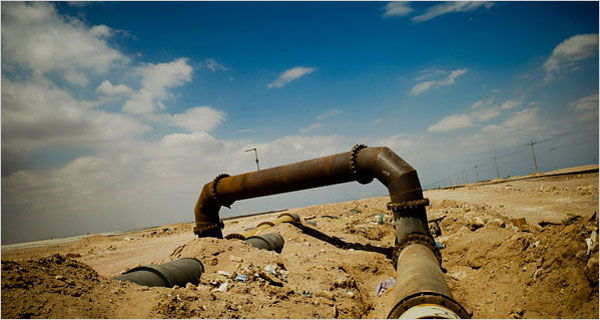
Pipelines to mines siphon water from some of the driest towns on earth, in northern Chile.
By ALEXEI BARRIONUEVO
Source: The New York Times. March 15, 2009.
QUILLAGUA, Chile — During the past four decades here in Quillagua, a town in the record books as the driest place on earth, residents have sometimes seen glimpses of raindrops above the foothills in the distance. They never reach the ground, evaporating like a mirage while still in the air.
What the town did have was a river, feeding an oasis in the Atacama desert. But mining companies have polluted and bought up so much of the water, residents say, that for months each year the river is little more than a trickle — and an unusable one at that.
Quillagua is among many small towns that are being swallowed up in the country’s intensifying water wars. Nowhere is the system for buying and selling water more permissive than here in Chile, experts say, where water rights are private property, not a public resource, and can be traded like commodities with little government oversight or safeguards for the environment.
Private ownership is so concentrated in some areas that a single electricity company from Spain, Endesa, has bought up 80 percent of the water rights in a huge region in the south, causing an uproar. In the north, agricultural producers are competing with mining companies to siphon off rivers and tap scarce water supplies, leaving towns like this one bone dry and withering.
“Everything, it seems, is against us,” said Bartolomé Vicentelo, 79, who once grew crops and fished for shrimp in the Loa River that fed Quillagua.
The population is about a fifth what it was less than two decades ago; so many people have left that he is one of only 120 people still here.
Some economists have hailed Chile’s water rights trading system, which was established in 1981 during the military dictatorship, as a model of free-market efficiency that allocates water to its highest economic use.
But other academics and environmentalists argue that Chile’s system is unsustainable because it promotes speculation, endangers the environment and allows smaller interests to be muscled out by powerful forces, like Chile’s mining industry.
“The Chilean model has gone too far in the direction of unfettered regulation,” said Carl J. Bauer, an expert on Chile’s water markets at the University of Arizona. “It hasn’t thought through the public interest.”
Australia and the western United States have somewhat comparable systems, but they contain stronger environmental regulation and conflict resolution than Chile’s, Dr. Bauer said.
Chile is a stark example of the debate over water crises across the globe. Concerns about shortages plague Chile’s economic expansion through natural resources like copper, fruits and fish — all of which require loads of water in a country with limited supplies of it.
“The dilemma we are facing is whether we can permit ourselves to continue to develop with the same amount of water we have now,” said Rodrigo Weisner, Chile’s water director in the Public Works Ministry.
“There is no political consensus about how to deal with the challenge of producing the resources we have — including the biggest reserves of copper in the world — in a country that has the most arid desert in the world,” Mr. Weisner said.
Fernando Dougnac, an environmental lawyer in Santiago, said that balance was particularly difficult because the “market can regulate for more economic efficiency, but not for more social-economic efficiency.”
Lately, the country’s approach to water has been showing some cracks. In the Atacama desert city of Copiapó, unbridled water trading and a two-year drought mean that “there are many more water rights for the river than water that arrives from the river,” Mr. Dougnac said.
Quillagua is in Guinness World Records as the “driest place” for 37 years, yet it prospered off the Loa River, reaching a population of 800 by the 1940s. A long-haul train stopped here — today the station is abandoned — and the town’s school was near its 120-student capacity. (Today there are 16 students.)
That prosperity first began to ebb in 1987, when the military government reduced the water to the town by more than two-thirds, said Raul Molina, a geographer at the University of Chile. But the big blows came in 1997 and 2000, when two episodes of contamination ruined the river for crop irrigation or livestock during the critical summer months.
An initial study by a professor concluded that the 1997 contamination had probably come from a copper mine run by Codelco, the state mining giant. The Chilean government then hired German experts, who said the contamination had a natural origin.
Chile’s regional Agriculture and Livestock Service, part of the Ministry of Agriculture, refuted those findings in 2000, saying in a report that people, not nature, were responsible. Heavy metals and other substances associated with mineral processing were found that killed off the river’s shrimp and made the water undrinkable for livestock. (Drinking water for residents had been transported in for decades.)
Codelco, the world’s largest copper miner, rejects any responsibility. Pablo Orozco, a company spokesman, said that the river water had been bad for years, and that heavy rains around the time of the contamination episodes had briefly swelled it, sweeping sediments and other substances into the water.
But the debate is largely academic, because without suitable water to raise crops, many residents saw no reason to continue resisting outside offers to buy the water rights in their town. One mining company, Soquimich, or S.Q.M., ended up buying about 75 percent of the rights in Quillagua. Most residents moved away; those who remain average around 50 years old.
“Quillagua cannot resist much longer,” said Alejandro Sanchez, 77, pointing a cane at a parched, grassless field where he once grew corn and alfalfa.
In 2007, the national water agency started investigating claims that Soquimich was extracting even more water from the Loa River than it was due. The inquiry is still pending, officials said, though the company says it has never taken more water than it owns rights to.
But early last year, the regional water authority started satellite monitoring along the Loa. After recording no water at all in the summer of 2007, Quillagua suddenly received small amounts last year, and again this January.
That has made water authorities suspicious that companies had been draining more water than permitted, according to Claudio Lam, a regional director for the Chilean water agency.
Even so, the water arriving in the summer is still not enough to produce crops, said Victor Palape, the chief of the Aymara Indians in Quillagua.
In a cruel twist, the town survives only because of daily water trucks that are partly financed by Codelco and Soquimich, the two companies that residents blame most for their troubles.
Quillagua’s residents remain determined. Mr. Palape, who owns the town’s main restaurant, still dreams of attracting tourists to the 108 meteor crater sites in and around Quillagua.
His sister Gloria is equally proud of Quillagua’s place in history.
“To be able to live in the driest place in the world, with everything that has happened, the people have to be resilient, to be stubborn,” she said. “We are not giving up.”
Pascale Bonnefoy contributed reporting from Santiago, Chile.
